|
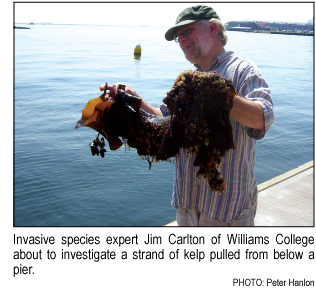 On
the trail of invasive species On
the trail of invasive species
By Peter J. Hanlon
[printer friendly version]
Deep-sea biologists have multi-million
dollar submersible vehicles. Physical oceanographers rely on
networks of satellites and buoys. And marine invasive species
experts use spatulas and nets. Clearly the latter are not the
gear-heads of the marine research world.
Despite the lack of high-tech
equipment, the search for non-native species has an international
appeal. Organisms from literally any point on the globe can be
transported to the Gulf of Maine through the ballast of cargo
ships, the baitfish industry, the release of aquarium pets into
the wild and fouling on the bottom of recreational boats.
It’s a big step for a handful
of hitchhiking organisms on a cargo ship to transition from pioneers
to reproducing population, but unfortunately the Gulf of Maine
is full of examples of species that have made the leap. Introduced
species such as the European green crab and Asian shore crab
prey on commercially valuable shellfish throughout the Gulf.
The green algae Codium fragile (also known as “dead
man’s fingers”) has been known to replace entire kelp
and eelgrass beds within New England and Atlantic Canada. A fast-growing
tunicate (Didemnum sp.) was found in 2003 to be smothering
a large area of the continental shelf like a mat on the productive
scallop fishing beds of Georges Bank.
Making an ID
Researchers are aware of the many ways that non-native species
can find their way into Gulf of Maine waters, but the question
of which invasive species exist within the Gulf is difficult
to answer. Since 2000, a team of scientists from throughout the
United States, Canada, the Netherlands, Brazil, Wales, Italy
and South Africa have participated in three “rapid assessment
surveys” of marine invasive species in the northeastern
United States coordinated by the Massachusetts Bays Program and
MIT Sea Grant.
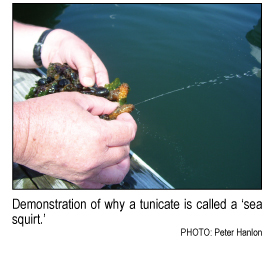 The weeklong surveys are invaluable opportunities
for taxonomic experts to quickly and accurately identify marine
species and determine whether they may be newly introduced organisms
that threaten the Gulf of Maine’s ecosystems, and if they
are introduced, where they are from and how they got here. Since
the scientists monitor the abundance of both native and non-native
species, they are also able to examine how the presence of introduced
species is affecting the native ecosystem. The weeklong surveys are invaluable opportunities
for taxonomic experts to quickly and accurately identify marine
species and determine whether they may be newly introduced organisms
that threaten the Gulf of Maine’s ecosystems, and if they
are introduced, where they are from and how they got here. Since
the scientists monitor the abundance of both native and non-native
species, they are also able to examine how the presence of introduced
species is affecting the native ecosystem.
The third and most recent rapid
assessment survey was conducted in July 2007. A team of 20 scientists
spent eight days visiting 17 sites stretching from Woods Hole,
Massachusetts to Rockland, Maine. The team visited permanently
floating docks and piers at each site, ensuring that they examined
a structurally similar habitat type at each location likely to
have a variety of marine organisms and several years of growth
underneath. The docks and piers selected were also located in
areas likely to have numerous pathways for non-native species
to be transported, such as active shipping ports.
On the road
With such a large crew and demanding schedule, the days were
planned down to the minute. Each day started out with an early
wake-up at the scientists’ hotel. After a quick breakfast,
the crew loaded into two vans and headed to the day’s first
site. As one might expect of vans full of taxonomists, conversations
steered towards, well, taxonomy, with the occasional friendly
scientific jousting.
Once at the site, the scientists
poured out of the vans, found a spot on the docks and, for the
next hour, lay down at the edge of the dock and scraped as many
organisms (both native and non-native) from the sides as they
could find. The equipment used was simple — spatulas to
scrape the organisms off and a net to catch them.
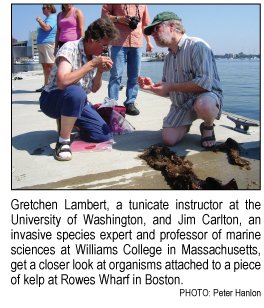 Sometimes
the organisms were attached to ropes and buoys — or in one
case a long stretch of plastic sheeting — that were dragged
onto the dock for examination. One scientist brought his wet
suit and snorkeling gear to collect and photograph species that
prefer the relative darkness under the docks. Sometimes
the organisms were attached to ropes and buoys — or in one
case a long stretch of plastic sheeting — that were dragged
onto the dock for examination. One scientist brought his wet
suit and snorkeling gear to collect and photograph species that
prefer the relative darkness under the docks.
Many of the common organisms
could be identified right away and were put back in the water.
A team member recorded the identified species. A representative
sample of all the organisms found at each site was collected
in a plastic bag and taken back to the lab that evening for identification.
It was common to see researchers
huddling together over a stretch of rope that had just been hauled
up, blanketed with brightly-colored organisms, and discussing
the identity of the attached species. Most of the scientists
had distinct areas of expertise and brought jars to collect specific
organisms of interest. So when, say, a club tunicate was found,
a research assistant would grab a sample and bring it to the
ascidian (sea squirt) expert.
After an hour or so, the researchers
began to organize their findings and headed back to the vans
to gulp down some cold drinks — no small detail during a
late July heat wave — and hit the road to inspect another
site, sometimes a few hours’ drive away. By late afternoon,
the group had visited three sites.
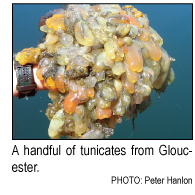 Once
back from the field, the day was far from over. The scientists
headed off to the lab where they remained for up to six hours
on some nights with only short breaks for pizza or Chinese or
whatever quick dinner awaited them. The researchers took shifts
identifying the species under a stereo microscope, which allows
viewing in three dimensions. The generalists wrote down the species
that they knew and passed on any questionable finds to the specialists.
Once all of the species were identified, a sample of the organisms
found at each individual site was placed in a jar as a permanent
record to be kept in a museum. Once
back from the field, the day was far from over. The scientists
headed off to the lab where they remained for up to six hours
on some nights with only short breaks for pizza or Chinese or
whatever quick dinner awaited them. The researchers took shifts
identifying the species under a stereo microscope, which allows
viewing in three dimensions. The generalists wrote down the species
that they knew and passed on any questionable finds to the specialists.
Once all of the species were identified, a sample of the organisms
found at each individual site was placed in a jar as a permanent
record to be kept in a museum.
Many of the non-native species
documented during the 2007 survey had been observed in the previous
two surveys (see sidebar), but this year did reveal an alarming
discovery: the northward expansion of Grateloupia, a
non-native red seaweed, into Cape Cod Bay and at a survey site
in Boston. The significance of this new species isn’t yet
understood, but it may impact other native seaweeds.
Next steps
While the survey was successful, it is just one of the steps
in the fight to control the spread of marine invasive species.
The goal of those involved is to continue their research by repeating
the process every several years to keep pace with potential future
invaders and their impact on native species. To fill the gap
between surveys, several citizen volunteer monitoring programs
have been established recently within the Gulf of Maine, and
survey organizers continue to hold workshops for coastal scientists,
managers, government agency personnel and graduate students to
give them the skills necessary to identify non-native species.
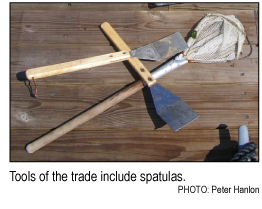 Equally
important is the effort to develop management plans and rapid
response protocols to address any new non-native species in the
Gulf, a task headed by organizations such as the Northeast Aquatic
Nuisance Species Panel, Massachusetts Aquatic Invasive Species
Working Group and Maine Marine Invasive Species Working Group.
Prevention is the focus of the plans, but should a new harmful
species be introduced, a rapid response protocol is needed to
let federal, state and local officials know what technologies
they have available to prevent an emergency. Equally
important is the effort to develop management plans and rapid
response protocols to address any new non-native species in the
Gulf, a task headed by organizations such as the Northeast Aquatic
Nuisance Species Panel, Massachusetts Aquatic Invasive Species
Working Group and Maine Marine Invasive Species Working Group.
Prevention is the focus of the plans, but should a new harmful
species be introduced, a rapid response protocol is needed to
let federal, state and local officials know what technologies
they have available to prevent an emergency.
Scientists monitoring non-native
species in the Gulf of Maine may not have the elaborate high-tech
equipment required by other marine researchers. Instead, regional
and international cooperation among coastal scientists and managers
— armed with a few spatulas — is the best way to effectively
prevent and control future invasions in our borderless marine
ecosystems.
Peter Hanlon is outreach and
policy coordinator for the Massachusetts Bays Program in Boston,
Massachusetts.
 Examples
of invasive species found on the most recent census
Examples
of invasive species found on the most recent census
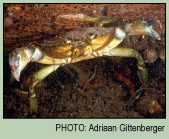 |
European
Green Crab
(Carcinus maenas)
Where
is it?
Established from Delaware to Nova Scotia, it is the most common
crab species in many locations throughout this range.
Why
is it a problem?
One of the Gulf of Maine’s dominant benthic predators, it
feeds on clams, oysters, crabs and mollusks and often is blamed
for the collapse of Maine’s soft shell clam industry.

|
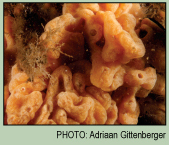 |
Colonial
Tunicate
(Didemnum sp.)
Where
is it?
Spreading in the Gulf of Maine, it was first observed in Maine
and Woods Hole, Massachusetts, in 1988, and since has been reported
from Maine to Connecticut.
Why
is it a problem?
It grows over a variety of surfaces, altering marine habitats
and threatening to interfere with fishing and aquaculture. It
grows aggressively over bivalves and may smother them or interfere
with their growth, and has no known predators.

|
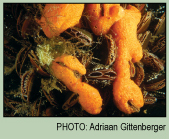 |
Sheath
Tunicate
(Botrylloides violaceus)
Where
is it? Its
range stretches from the Gulf of Maine to Florida.
Why
is it a problem?
It can grow over other organisms such as shellfish, competing
for food and resources and possibly leading to the other organisms’
death.

|
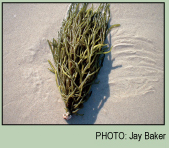 |
Green
Fleece Algae
(Codium fragile)
Where
is it?
It covers a region from the Gulf of St. Lawrence to North Carolina.
Why is it a problem? When this species becomes established
in shellfish beds, wave energy can lift the algae. As the algae
floats away, it carries its host shellfish away from its normal
habitat, resulting in another common name for this species, “oyster
thief.”

|
|
|
![]()
